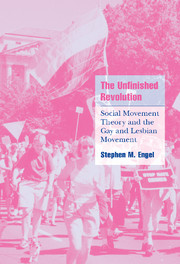Book contents
- Frontmatter
- Contents
- Notes on language
- Preface
- Introduction
- 1 Asked and answered: how questions can condition conclusions in social movement theory
- 2 Tracing the rainbow: an historical sketch of the American gay and lesbian movement
- 3 Tracing the rainbow: an historical sketch of the British gay and lesbian movement
- 4 Where and how it comes to pass: interest group interaction with political institutions
- 5 Asking the unasked question: grappling with the culture variable
- Conclusion
- Appendix: a survey of social movement theories
- Notes
- Bibliography
- Index
3 - Tracing the rainbow: an historical sketch of the British gay and lesbian movement
Published online by Cambridge University Press: 31 October 2009
- Frontmatter
- Contents
- Notes on language
- Preface
- Introduction
- 1 Asked and answered: how questions can condition conclusions in social movement theory
- 2 Tracing the rainbow: an historical sketch of the American gay and lesbian movement
- 3 Tracing the rainbow: an historical sketch of the British gay and lesbian movement
- 4 Where and how it comes to pass: interest group interaction with political institutions
- 5 Asking the unasked question: grappling with the culture variable
- Conclusion
- Appendix: a survey of social movement theories
- Notes
- Bibliography
- Index
Summary
The love that dare not speak its name in this century is such a great affection of an elder for a younger man as there was between David and Jonathan, such as Plato made the very basis of his philosophy, and such as you find in the sonnets of Michelangelo and Shakespeare … on account of it I am placed where I am now. It is beautiful, it is fine, it is the noblest form of affection. There is nothing unnatural about it.
Oscar Wilde, 1895The emergence and growth of the gay and lesbian movement in the United States during the post-war period is not an isolated phenomenon. Similar movements developed throughout the world, most notably in the democracies of western Europe and Canada. This chapter seeks to ascertain to what degree the British and American gay and lesbian movements resembled each other. As mentioned in the introduction, the British movement was selected for comparison because of the political institutional environment in which it evolved. That environment is discussed further in chapter 4. This chapter focuses on the movement history itself. What type of changing opportunity existed in the United Kingdom during the immediate post-war period? Did a British homophile movement exist? Did gay liberation take hold in Britain? What effect did AIDS have on the movement? Starting with the political opportunity provided by the Second World War, this chapter will trace the development of the British homophile movement, evaluate the law reform of 1967, assess the impact and effect of gay liberation, consider the influence of AIDS, and arrive at sundry conclusions regarding the movement's present status.
- Type
- Chapter
- Information
- The Unfinished RevolutionSocial Movement Theory and the Gay and Lesbian Movement, pp. 67 - 98Publisher: Cambridge University PressPrint publication year: 2001

